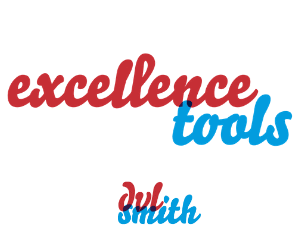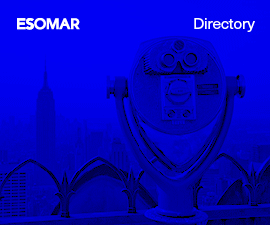- What we do
- Membership
- Knowledge
- Events
- Contact
Log in to your MyESOMAR account

You searched for: "" but we corrected it to "*"
Did you mean to search for ""? Click here to show those results.
The results has been filter on Tags containing Diary Method.
ANA has found 49 results for you, in
185 ms.
Currently showing results 1 to 9.
Didn’t find what you were looking for? Try the Advanced Search!
Research papers
 Dear {Diary_Name}:
Dear {Diary_Name}:
p.p1 {margin: 0.0px 0.0px 0.0px 0.0px; font: 12.0px 'Helvetica Neue'}p.p2 {margin: 0.0px 0.0px 0.0px 0.0px; font: 12.0px 'Helvetica Neue'; min-height: 14.0px}A.I. won't replace workers who do intellectual activities. Is this still true? Check this...
Catalogue: Congress 2019: The Global Data & Insights Summit
Authors: André Torales, Felipe Ferraz, Nick Nomm
Companies: INSITUM, Facebook
 September 8, 2019
September 8, 2019
Citation
Torales, Ferraz and Nomm (2019a, September 08). Dear {Diary_Name}:. ANA - ESOMAR. Retrieved April 20, 2024, from
https://ana.esomar.org/documents/dear-diary-name-
Research papers
 Raising diary response among young people
Raising diary response among young people
Response rates are among the hottest topics in the research industry. Panel research, in particular, is directly confronted with the effects of declining response rates. In the Netherlands, one of the hardest groups to get co-operation from is young...
Catalogue: ARF/ESOMAR Worldwide Radio 2001
Author: Marion Appel
Company: GfK
 April 1, 2001
April 1, 2001
Citation
Appel, M. (2001a, April 01). Raising diary response among young people. ANA - ESOMAR. Retrieved April 20, 2024, from
https://ana.esomar.org/documents/raising-diary-response-among-young-people
Research papers
 Comparison of two radio diary methodologies
Comparison of two radio diary methodologies
This paper describes the results of a parallel test of two methods of collecting radio tuning data with different diary designs. One diary design uses a pre-printed quarter hour approach where there is a row for each quarter hour in the day and the...
Catalogue: ARF/ESOMAR Worldwide Radio 2001
Author: Eva Tolkunow
 April 1, 2001
April 1, 2001
Citation
Tolkunow, E. (2001a, April 01). Comparison of two radio diary methodologies. ANA - ESOMAR. Retrieved April 20, 2024, from
https://ana.esomar.org/documents/comparison-of-two-radio-diary-methodologies
Research papers
 The toughest challenge
The toughest challenge
This paper discusses the method developed by Nielsen Media Research to gather out-of-home television viewing for children in daycare, school and other situations. Utilizing a personal diary data collection tool, information was gathered from families...
Catalogue: ESOMAR/ARF Seminar 1998: Electronic Media And Measurement Trends
Author: Rachel Mueller-Lust
Company: Nielsen
 June 15, 1998
June 15, 1998
Citation
Mueller-Lust, R. (1998a, June 15). The toughest challenge . ANA - ESOMAR. Retrieved April 20, 2024, from
https://ana.esomar.org/documents/the-toughest-challenge-
Research papers
 What radio stations call themselves and what diarykeepers call them
What radio stations call themselves and what diarykeepers call them
The number and success of radio stations are strongly linked to station format. Listener demographics are linked to the station formats. Thus, separating the effect of station format from listener demographics is difficult. The bigger formats are...
Catalogue: 2nd Radio Research Symposium
Author: Thomas W. White
 June 15, 1997
June 15, 1997
Citation
White, T. W. (1997a, June 15). What radio stations call themselves and what diarykeepers call them. ANA - ESOMAR. Retrieved April 20, 2024, from
https://ana.esomar.org/documents/what-radio-stations-call-themselves-and-what-diarykeepers-call-them
Research papers
 Radio audience measurement
Radio audience measurement
This paper reports on an investigation of the relative performance of one, two and four week diaries for radio audience measurement. A special four week diary study carried out in 1992 by Research Services Limited for RAJAR has been re-analysed to...
Catalogue: 2nd Radio Research Symposium
Author: Steve Wilcox
 June 15, 1997
June 15, 1997
Citation
Wilcox, S. (1997a, June 15). Radio audience measurement. ANA - ESOMAR. Retrieved April 20, 2024, from
https://ana.esomar.org/documents/radio-audience-measurement
Research papers
 Implementing a "stick-in" diary in the United Kingdom
Implementing a "stick-in" diary in the United Kingdom
A pre-printed, or closed, diary format had been used by RAJAR since 1992. However, due to the growing number of stations in the United Kingdom, new additions to the pre-printed list meant reaching the physical format limits. Following the results of...
Catalogue: 2nd Radio Research Symposium
Authors: Erhard Meier, John Stockley
 June 15, 1997
June 15, 1997
Citation
Meier and Stockley (1997a, June 15). Implementing a "stick-in" diary in the United Kingdom. ANA - ESOMAR. Retrieved April 20, 2024, from
https://ana.esomar.org/documents/implementing-a-stick-in-diary-in-the-united-kingdom
Research papers
 A single source success
A single source success
This paper addresses the historic background related to the introduction of a lifestyle questionnaire in the regular Radio Audience ratings diaries in Australia, the pilot test and the eventual introduction of a full service. We look at the...
Catalogue: Radio Research Symposium 1995
Author: Mark Neely
 July 1, 1995
July 1, 1995
Citation
Neely, M. (1995a, July 01). A single source success. ANA - ESOMAR. Retrieved April 20, 2024, from
https://ana.esomar.org/documents/a-single-source-success
Research papers
 The UK reach and frequency model
The UK reach and frequency model
RAJAR, the new joint industry measurement system for UK radio, was launched in 1993. As in the past, the RAJAR survey uses a one-week self-completion diary and a model is required to estimate station or schedule reach beyond seven days. Changes in...
Catalogue: Radio Research Symposium 1995
Authors: Sue Gray, Steve Wilcox
 July 1, 1995
July 1, 1995
Citation
Gray and Wilcox (1995a, July 01). The UK reach and frequency model. ANA - ESOMAR. Retrieved April 20, 2024, from
https://ana.esomar.org/documents/the-uk-reach-and-frequency-model







